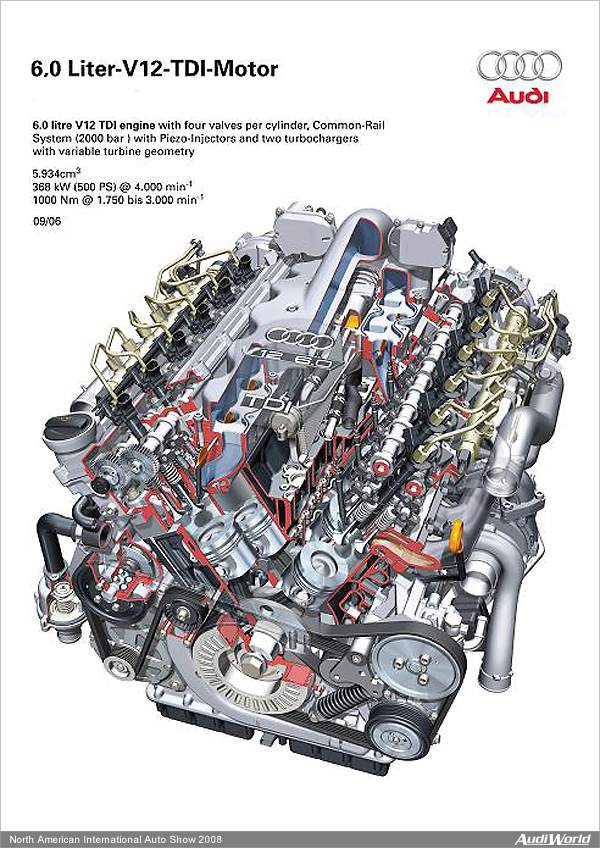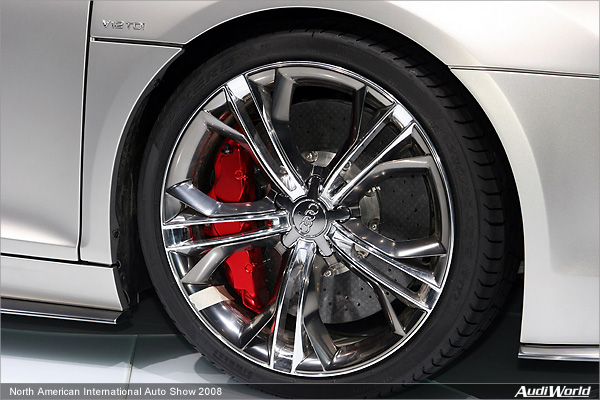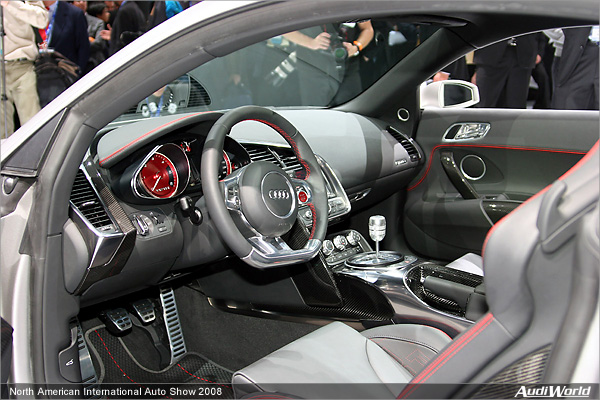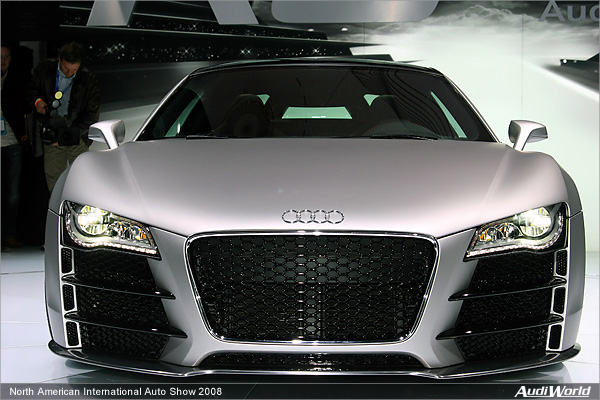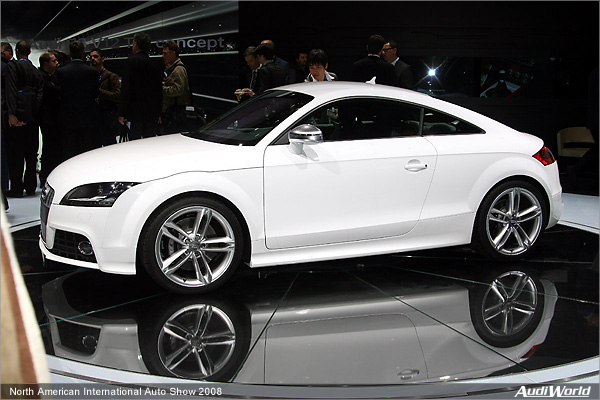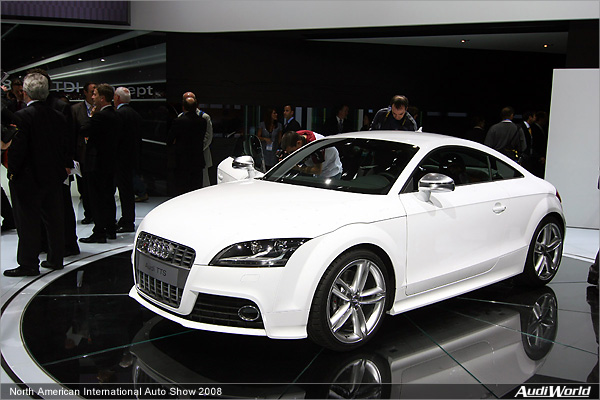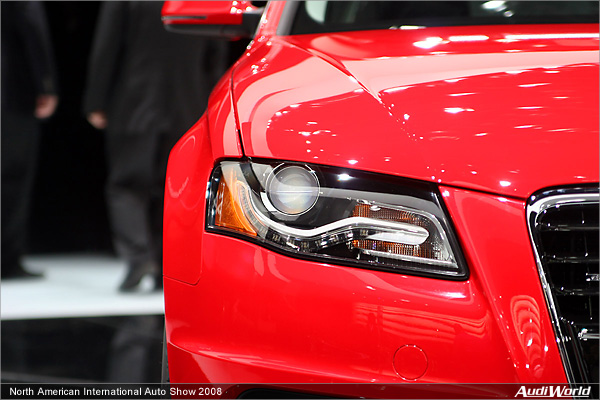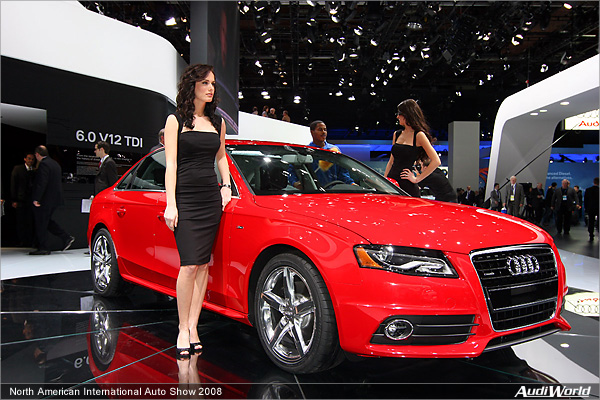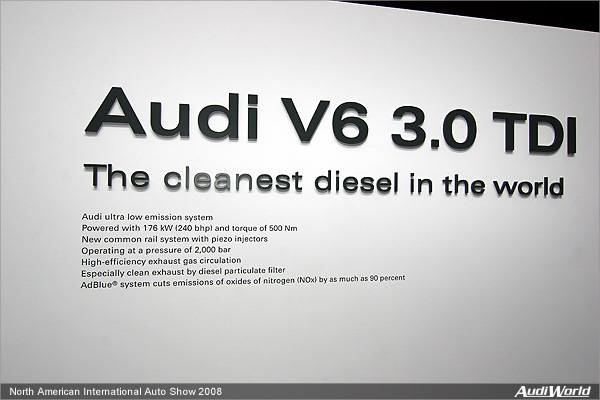NAIAS 2008: Audi Recap
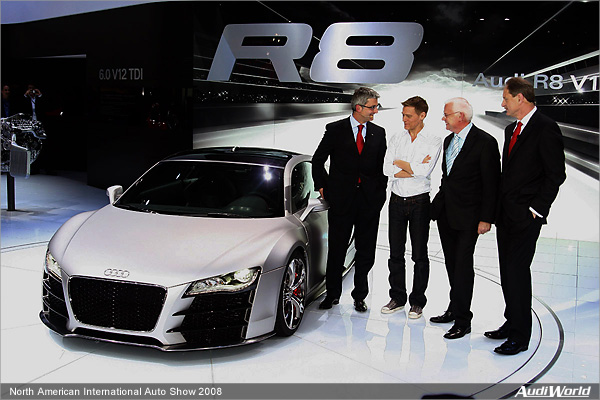
Ever since introducing the first production turbocharged direct injection passenger car TDI diesel engine in 1980’s, Audi has been at the forefront of compression ignition technology. After becoming the first marque to earn the overall win at Le Mans with diesel power, the next logical step was to pass the experiences and technology down from the race program to the consumer level. After all, this reason alone is exactly why Audi isn’t in any hurry to throw their hats into the Formula-1 ring
the technology there is just too far removed from production passenger cars.
Back in late 2006, Audi promised the most powerful passenger car diesel engine in the world. This came in the form of a race inspired 6.0 liter V12 twin turbo TDI engine cranking out about 500 horsepower and 738 ft-lbs of torque. At the engine’s premiere in Paris, it was openly known that the only Audi platform capable of accepting the large engine was the Q7 sport utility vehicle. Naturally there were inquiries on whether this beastly über-torquer could be somehow fit within the svelte R8 supercar. Audi’s answer was an adamant “no!”.
Luckily for us, Audi isn’t always right.
About a month ago, rumors from Europe trickled back over the pond suggesting that Audi had found a way to “shoehorn” this CGI block clean diesel engine into the universally acclaimed R8. Audi immediately had our attention. Never has anyone released a diesel vehicle with such sporting intentions. With Audi’s PR machine running full blast trying to gear Americans up for TDI technology in North America, dropping such an outrageous diesel concept on the Detroit Auto Show might be just what they need to spark (or should I say glow) interest in this alternate fuel technology.
After some fog effects and a quick song from Bryan Adams, out rolled the most aggressive vehicle ever to come out of Audi’s design studios. This was clearly not your everyday R8. From the oversized grilles to increase engine cooling capacity, to the fully functional roof intake scoop, to the stunning satin silver paint, Audi’s R8 V12 TDI proved itself to be an attention grabbing design study.
On paper, the statistics are staggering. This cetane sipping monster delivers 500 horsepower and an even 1,000 Newton-meters of torque (working out to about 738 ft-lbs in English units) distributed through a viscous quattro AWD drivetrain and 6 speed manual transmission. 0-60 times are said to be pegged at a conservative 4.2 seconds. Top speed? “Well over” 185 mph. Massive candy red painted monoblock calipers clamp firmly on oversized carbon ceramic rotors, which promise massive stopping reserves and an extended service life of up to 186,000 miles. Audi’s magnetic ride suspension guarantees damping versatility making the car perfectly suited for real world streets, or the Nürburgring depending on your mood and the position of the steering wheel mounted control switch. A more aggressive body kit and vertically retractable rear spoiler increase downforce for high speed stability. The roof mounted air intake, which is clearly inspired by the Audi Avus supercar concept of 1991, ensures the engine can swallow in excess of 1,500 kg per hour of cool air, necessary to produce 500 horsepower.
Although the R8 is renowned for being the segment leader in terms of interior fit and finish, this special edition with it’s extra carbon fiber, brightly colored dash treatment, and full color DIS raise the bar even further. The special racing inspired “Schallensitze” seats adorning the R8 logo are a nice touch.
Unbridled by Le Mans displacement restrictions, Audi has increased the capacity of their Le Mans winning TDI engine from 5.5 liters to 6.0 (technically 5934 cc) for the “street” version. The race program’s aluminum block is also jettisoned in favor of a cast Compacted Graphite Iron (CGI) block for its favorable long term durability, fatigue, and wear resistance. The GJV-400 material is already in use on Audi’s current V6 and V8 TDI offerings, and allowed the V12 designers to reduce weight by 15% over a traditional grey cast iron block. For packaging reasons, Audi has decided to bring the angle of the vee in to a narrow 60 degrees. The bore (83 mm) and stroke (91.4 mm) are the same as other current Audi TDI offerings reducing development and tooling costs. Although the end product is extremely compact for a 500 hp twelve cylinder engine, it’s still longer than the current gasoline 4.2 liter V8. As a result, the stowage space behind the seats in the R8 (usually reserved for golf bags) has been sacrificed to make room for the diesel engine.
Through multiple prototype R8 fires, Audi has discovered that thermal management is absolutely critical in this mid engine supercar. The R8 V12 TDI has no less than five heat exchangers (coolant radiator, two intercoolers, oil cooler, EGR cooler) to carefully control the approximately 750,000 watts of heat emitted by the 6.0 liter engine at full song.
As with any modern diesel, the injection system can make or break the performance. In order to make a diesel engine run cleanly AND powerfully, you must inject the fuel very precisely and fully atomized. This is accomplished by utilizing a cutting edge Bosch common rail injection system capable of producing up to 2,000 bar (29,000 psi!) of line pressure. In conjunction with 8 orifice injectors, diesel fuel is injected multiple times (or “events”) during the combustion stroke to minimize emissions and reduce the typical diesel “clatter”.
Interestingly enough, this engine (as more and more cutting edge diesel engines) makes use of a throttle plate very similar to a gasoline engine. By regulating the amount of air the engine sucks in, Audi can gain a tighter control over emissions and directly influence the exhaust gas temperatures (also monitored).
The standard particle filter (to reduce soot, you won’t see any smoke from this engine!) must be cleaned from time to time under normal engine operation, and the careful regulation of exhaust gas temperatures and post combustion injection events can do this automatically. Summed up, this highly intelligent engine is constantly adjusting to operate as efficiently as possible with minimum emissions.
Diesel engines are well known to have amazing low RPM torque characteristics partially due to high compression ratios (16:1 in this case). Forged Mahle pistons, similar to those used in the R10 racing program, are specified to cope with the 180+ bar of cylinder pressure seen at peak torque. Such high cylinder pressures demand a robust engine design to handle the additional stresses over gasoline engines. Robustness is what typically adds weight and cost to diesel engines, though it pays off with an extended operating lifetime. Hardened engine blocks, forged internals, ceramic or diamond coated piston rings, and relatively low engine speeds mean that most modern diesel engines are capable of going twice as far (or more) between major overhauls compared to typical gasoline engines with this engine being no exception. You know that expression about brick outhouses
well, it certainly applies here.
In order to really impress Americans with their diesel savoir faire, Audi has proven that TDI technology can make a supercar that is immensely powerful, economical, and clean as well. Four primary emissions control systems ensure that the exhaust coming out of the rear of the R8 TDI is just as clean as the air sucked into the roof mounted intake scoop.
The first step in the exhaust path is the Exhaust Gas Recirculation (EGR) system. High volumes (likely up to 50% depending on engine speed/load, no DEI jokes please!) of exhaust gas is rerouted from the exhaust stream, through a high efficiency cooler situated in the engine’s vee, and back into the intake tract in order to reduce NOx emissions. The downside of EGR is that it increases the amount of soot and particulate matter in the exhaust stream.
No matter, as the next systems downstream of the EGR are twin particle filters. These filters are capable of trapping 99% of soot and solid matter contained within the exhaust stream. Thanks to DPF’s, black smokey diesels are a thing of the past. The condition of the particle filter is monitored by the ECU with pressure transducers mounted at the inlet and outlet of the DPF. When the pressure differential reaches a set limit, the ECU knows that the filter needs to be cleaned. To accomplish this, the car engine will throttle the intake airstream and inject extra fuel very late in the combustion stroke which will raise exhaust gas temperatures enough to “burn off” the particle matter within the filter, and clean it out. No driver intervention is required, and the process is seamless.
After the DPF, comes a special catalyst system called an SCR (Selective Catalytic Reduction). A urea liquid called AdBlue is injected into the exhaust stream and breaks NOx pollutants down into pure Nitrogen and water within the SCR catalyst. The finely controlled metering of the AdBlue injection means refilling the system is only required during normal scheduled service appointments at the dealer. All of these features allow the R8 V12 TDI to meet the highly stringent Euro 6 emission standards, likely to be implemented in 2014. Needless to say, it’s more than clean enough to pass the emission requirements anywhere in the US.
By drawing on years of production car and racing experience, Audi has pulled out all the stops and produced arguably the cleanest and most economical supercar ever. It seems like a no-brainer to bring this world-beater into production, right? Well, not so quickly. There are a few drawbacks.
The massive torque production of the V12 diesel requires that every part required to carry the engine’s torque be incredibly strong. From the reciprocating parts in the engine to the wheels and everything in between must be reinforced over standard R8 parts which adds considerable weight and cost. The end result is that the R8 V12 TDI weights about 220 kg more than the gasoline 4.2 liter R8. Approximately 100 kg of weight gain can be attributed to the diesel engine, 70 kg to the drivetrain, and 50 kg to the remainder of the car.
Will a 3800 lb+ R8 still be able to deliver a highly sporting characteristic demanded by high end supercar customers? We believe so, but we’ll have to wait for real world test numbers to find out. We certainly know where they can find a willing test driver or two! Stay glued to AudiWorld.com for the latest news and in depth information on Audi’s North American diesel future.
Marking the 10th year anniversary of the one-of-a-kind Audi TT sports coupe, Audi had some celebration tricks up their sleeves. An acoustic serenade by the venerable rocker Bryan Adams proclaimed “The only thing that looks good on me, is you.” At the same time, the cover was torn off of the first variant of the TT line to earn the “S” performance badge.
The expected requisite of performance and luxury appointments have been added to the TTS to make it “go” as well as it looks. Power comes from the most potent version of the turbocharged 2.0 liter TFSI inline 4 cylinder available, kicking out 272 horsepower and 258 ft-lbs of torque. Power delivery includes a the tabletop flat torque curve we’ve come to expect from turbocharged Audi engine ensuring flexible performance at nearly any engine speed. A standard Haldex based quattro AWD system ensures the driver makes good use of the power on tap.
One of the key features of the 2nd generation TT is the relatively light curb weight. Audi’s innovative use of aluminum on the TT’s unibody structure is largely to thank. Despite the higher powered reinforced engine, larger brakes, a two position adjustable magnetic ride suspension system, and quattro AWD, the overall weight is claimed to be only 3075 lbs. Light weight is the secret in keeping performance, and efficiency high. The TTS has both in spades offering a 0-60 time in the very low 5 second range while averaging about 29 mpg in mixed driving. Seldom does a car return such high performance and fuel consumption marks. The TTS will be available in coupe or cabrio configuration with the choice of conventional manual transmissions or DSG units.
Not to be forgotten is the premiere of the B8 A4 on US soil which is scheduled to go on sale this coming spring. Audi was proud to show off their new found curves for the A4 line displaying a stunning red specimen being flanked by two beautiful models. To round out Audi’s display, an S5, A8 W12, and Q7 3.0 diesel was also on hand. Sharing emission fighting technology with the R8 V12 TDI, the Q7 3.0 diesel puts up the bold claim of being the cleanest diesel in the world, easily being 50-state legal in the US. See the cutaway photos in our photo galleries to get a better view.
Although the TTS is confirmed for series production, the future of the R8 V12 TDI is still up in the air. Audi will carefully weigh the public and industry response to this design concept and determine the diesel burning supercar’s fate at a later date. One thing is for certain though; the whole idea of this car has everyone talking about diesel power in the US
which is exactly what Audi’s intention is.
Keep checking back with AudiWorld.com for the latest news and developments on Audi’s entire product range, including up and coming diesel models.
|

 Audi made one thing clear during the 2008 North American International Auto Show, they were there to impress. Although slightly smaller in scale than the larger European shows, Detroit’s NAIAS is the largest in North America and held right in the backyard of the US automakers. Given the worldwide attention the show receives inside and outside the auto industry, Audi is cleverly using this venue to gauge interest in their latest concept design study; the R8 V12 TDI diesel supercar. The additional world premiere sharing the spotlight was the TTS, a high performance variant of the stylish and sophisticated TT.
Audi made one thing clear during the 2008 North American International Auto Show, they were there to impress. Although slightly smaller in scale than the larger European shows, Detroit’s NAIAS is the largest in North America and held right in the backyard of the US automakers. Given the worldwide attention the show receives inside and outside the auto industry, Audi is cleverly using this venue to gauge interest in their latest concept design study; the R8 V12 TDI diesel supercar. The additional world premiere sharing the spotlight was the TTS, a high performance variant of the stylish and sophisticated TT.
